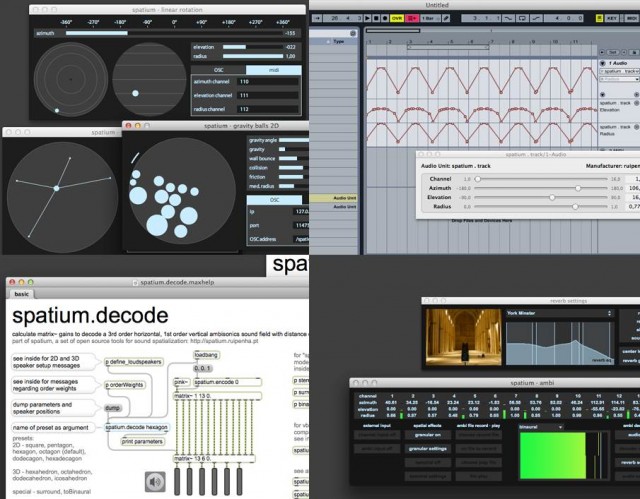Human perception is capable of astounding feats of sensitivity in localizing sound – it is very likely an evolutionary trait. Yet musicians rarely tread beyond simple stereo, perhaps because it’s tough to be creative in space without something that’s visual and intuitive, something that looks like what you’re hearing.
Spatium is an extraordinary set of tools for sound spatialization, built in [graphical patching language] Max/MSP and [creative code environment] Processing. It’s free and open source, a set of modules anyone can use to manipulate sound in space or as the basis of their own tools. Portugese artist and developer Rui Penha, who built these as part of his dissertation research, explains:
[Spatium] are a set of free, open source and modular software tools for sound spatialization, comprised of spatialization engines, spatialization interfaces and plugins.
The interfaces are basically Processing sketches that send OSC, so they can also be useful for other purposes. Also, the plug-ins are basically OSC automation recorders, so they can also be useful if you want to write OSC automation along the audio on your sequencer tracks.
This is a research project, not a commercial endeavor, so for now the tools are Mac-only and you’ll probably want a bit of experience before you try to set them up. But Rui has prepared some very nice videos. And you have a number of ways you can use these tools: as Max patches, as Processing sketches, as interfaces for other tools (even visual as well as sonic, it seems), and even as plug-ins. In fact, if you read between the lines above, you may already have worked out that these could be powerful OSC automation and sequencing tools for a variety of applications (hello, visualists).
Here’s an overview of what the tool set can do:
spatium.overview from Rui Penha on Vimeo.
And since this is not only an exercise in tool-building, here’s a beautiful performance work that uses the system:
pendulum from Rui Penha on Vimeo.
Description:
for flute, bass clarinet, piano, violin, cello, electroacoustics and video, both generated in realtime.
The video is following the piano events and controls the spatialization of the electroacoustic part, using the upcoming ‘spatium’ software. The video is done in Processing and the audio in Max/MSP, with sounds from a Continuum fingerboard. The original audio is for an hexaphonic loudspeaker setup, here a stereo mix down. Also, the original video was 50fps and the movements were much clearer, but I had to upload a 25fps version due to vimeo limits.
Live recording by Sond’Ar-te Electric Ensemble – Sìlvia Cancela (fl.), Luís Gomes (b.cl.), Joana Gama (pno.), Suzanna Lidegran (vln.), Nelson Ferreira (vlc.) and Guillaume Bourgogne (conductor) · at Goethe-Institut Portugal, October 2012.
Seeing this work is nicely serendipitous, as I was just yesterday attending a lecture by London-based artist Memo Atken as he presented, among other works, his Simple Harmonic Motion series. To me, these kinds of connections make work stronger – for all the fear of “someone else has done that,” it seems people should be more concerned when people aren’t working in similar directions.
Simple Harmonic Motion study #2a from Memo Akten on Vimeo.
And that brings us full-circle to the importance of this being free and open: to make spatialization a richer component of musical output, you need to share. You need other musicians and composers working with spatial media in order to more regularly program that music, whether we’re talking clubs, galleries, or concerts. You need to better develop musical techniques to make these expressive. And you need people sharing ideas and interfaces in order to progress. Absent commercial models for funding development, you may also need to share free tools with one another just to get the tools the maturity at which they’re most useful. So, free development is a great place to start – and it’s a pleasure to get to spread the word, having talked to Rui for some time about this long-term work of his. Let’s go have a play, shall we?
You’ll find videos of all the different tools at the official site, including downloads and source.
http://spatium.ruipenha.pt/
